Tourism in Zanzibar
Tourism in Zanzibar includes the tourism industry and its effects on the islands of Unguja (known internationally as Zanzibar) and Pemba in Zanzibar a semi-autonomous region in the United Republic of Tanzania.[1] Tourism is the top income generator for the islands, outpacing even the lucrative agricultural export industry and providing roughly 25% of income.[2][3] The main airport on the island is Zanzibar International Airport, though many tourists fly into Dar es Salaam and take a ferry to the island.
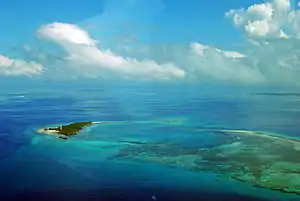
The government plays a major role in promoting the industry, with the official government tourist page stating, "The Vision of the Government of Zanzibar regarding tourism is “To become one of the top tourism destinations of the Indian Ocean, offering an up market, high quality product across the board within the coming 17 years.” Zanzibar Commission for Tourism recorded more than doubling the number of tourists from the 2015/2016 fiscal year and the following year, from 162,242 to 376,000.[4]
The increase in tourism, has led to a significant environmental impacts and mixed impacts on local communities, who were expected to benefit from economic development but in large part haven't.[3][5] Communities have witnessed increasing environmental degradation, and reducing the access of local communities to the marine and coastal resources that are the center of tourist activity.[3]
History
The opportunity for growing the tourism in Zanzibar started in the 1980s, before which tourism largely didn't exist.[3][1] As of 1985 there were only 19,000 annual tourists.[3] Restructuring of the economy in the 1980s due to a IMF instigated Investment Protection Act allowed for an increase in local usinesses working in the industry.[1] Increased growth of foreign-invested accommodations and hotels on the islands has allowed for a growth in tourism from Italiy, the UK, other parts of Europe and Africa.[1]
In 2011 and 2012, two tourist ferries sank in the islands.[3]
Following shutdowns due to the COVID 19 pandemic, Zanzibar reopened the islands in June 2020 without quarantine measures.[6] In late 2020, the government promoted confidence in the tourism industry in Zanzibar, and saw a partial recovery of 60% of the number of inbound tourists that it had seen in previous years by November.[7]
Government activity
The tourism in the region is promoted both by the Zanzibar Commission for Tourism Authority and Tanzania Tourist Board.[1] The semi-autonomous nature of Zanzibar makes analysis of the situation more similar to Small Island Developing States.[1] A 2014 study found that the planning, policy and governance practices for the local tourism industry was poor.[1] Moreover, widespread corruption has led to government officials protecting investors and hotel owners, many of whom are not local parts of the economy.[3]
Attractions
The principal grouping of attractions on Zanzibar are: coastal tourism, terrestrial wildlife, dhow cruising and spice tours.
Stone Town

Zanzibar's capital is the historical Stone Town, home to much of Zanzibar's tourism industry. It is also a World Heritage Site. The town is home to numerous historical and cultural sites, including Makusurani graveyard (where many of the islands previous Arab rulers are buried), House of Wonders (a four story building which was the first place on the islands with electrical lights), Hamamni and Kidichi Persian Baths (the first public baths on the island), Dunga Ruins (Ruins of a palace built in the 15th century by the rulers of the time), and the Peace Memorial Museum, which serves a national historical museum detailing the island's long history.
Coastal tourism
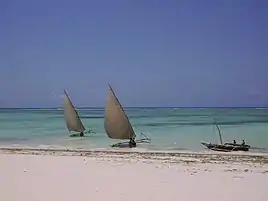
Zanzibar is home to large amounts of beaches and clear Indian Ocean water, as well as coral and limestone scarps which allow for significant amounts of diving and snorkeling. The diving and snorkeling are done in marine parks. The aquatic life seen includes; dolphins, moray eels, lion fish, octopus and lobster Tourists may also go dhow cruising around the small islands. Tourists can view the sunset and have refreshments on board. Some of these marine spaces are providing important ecosystem preservation, such as Chumbe Marine Park.
Spice Tour
The town is famous for its spice tours. Tourists visit the various coconut and spice plantations in the island. Zanzibar is known for its variety of spices that are used to prepare food, cosmetics and medicines. Some of the fruits available include; banana, coconut, lime, jackfruit and breadfruit. The spices available include; clove, nutmeg, black pepper, vanilla and coriander. Zanzibar is also known for its salt and seaweed farms that may be visited by tourists on request.
Jozani forest and Kidike Root Site
The Jozani forest is located in the central east region of Zanzibar consisting of a large mangrove swamp. The forest is home to the rare red colobus monkey. The forest is also home to 40 species of bird and 50 species of butterfly. The Kidike root site is a great place to view the endangered Pemba flying fox.
Challenges
Quality of infrastructure
As of 2014, 1/3 of housing did not meet international tourist standards.[1] And accommodations that do meet that standard are expensive to operate, often having to generate their own electricity because of poor reliability of the local grid.[1]
Local economy
A 2015 study concluded that the tourist economy did not contriute to pro-poor growth.[5] There is limited evidence that the tourism has helped with poverty alleviation.[3]
Though there is a lot of work in the face of the tourism industry, it doesn't all benefit local labor.[1] 2009 estimates of workers in the tourism industry sugested that 83% of unskilled jobs in hotels and 70% in restaurants but only 46% of managerial positions in hotels and just 11% in restaurants were held by local Zanzibari staff.[1] Professional development opportunities on the island, for example the Zanzibar Hotel and Tourism Institute, are too expensive for locals.[1] A 2020 article, highlighted thousands of Maasai men migrating to join the tourism industry on the island and using their ethnic dress to sell goods and services, includin sexwork.[8]
Most of the food good eaten in the tourism sector can't be produced locally and increases the prices for the local community.[1]
Water resources
Tourists use as much as 15 times as much water as local, which combined with saltwater intrusion and general water scarcity raises serious water equity issues.[9][10]
Marine environment
The growing tourist industry is leading to a significant amount of plastic marine debris and human waste from untreated wastewater discharge.[11][12]
Climate change
45% of the local economy is dependent on the marine ecosystem, including much of the tourism.[13] However, because much of the infrastructure and tourism is on the coast, many of the tourist destinations already are experiencing salt-water intrusion, sea level rise and coastal erosion—and much of this is expected to get worse as sea level rise continues.[13] Other factors and risks include rising temperatures and uncertainty about freshwater supply.[13]
Government actors coordinated by the First Vice President Office are working to build a National Framework for Climate Change Response which includes new rules and mechanisms for addressing threats to the tourism sector.[13] Actors feel like the effectiveness of climate change adaptation have been hampered by resourcing and expertise needed to implement the programs.[13]
Picture gallery
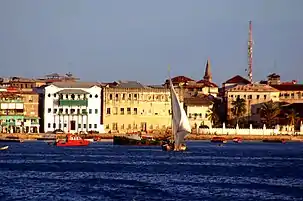 Stone Town
Stone Town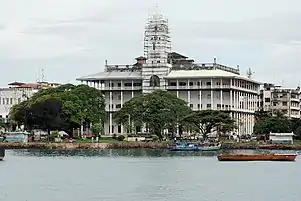 House of Wonders
House of Wonders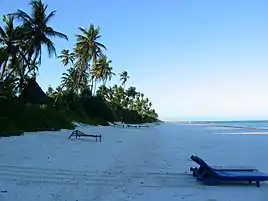 Zanzibar West Coast beach
Zanzibar West Coast beach
References
| Wikivoyage has a travel guide for Zanzibar. |
- Sharpley, Richard; Ussi, Miraji (January 2014). "Tourism and Governance in Small Island Developing States (SIDS): The Case of Zanzibar: Tourism and Governance in Zanzibar". International Journal of Tourism Research. 16 (1): 87–96. doi:10.1002/jtr.1904.
- Zanzibar islands ban plastic bags BBC News, 10 April 2006
- Lange, Glenn-Marie (2015-02-01). "Tourism in Zanzibar: Incentives for sustainable management of the coastal environment". Ecosystem Services. Marine Economics and Policy related to Ecosystem Services: Lessons from the World’s Regional Seas. 11: 5–11. doi:10.1016/j.ecoser.2014.11.009. ISSN 2212-0416.
- Yussuf, Issa (19 April 2017). "Tanzania: Number of Tourists to Zanzibar Doubles As Tourist Hotels Improve Service Delivery". allAfrica. Retrieved June 4, 2019.
- Rotarou, Elena (December 2014). "Tourism in Zanzibar: Challenges for pro-poor growth". Caderno Virtual Dde Tourismo. 14 (3): 250–265.
- Walker-Arnott, Ellie. "Zanzibar is welcoming travellers again so you can live out your tropical dreams". Time Out Worldwide. Retrieved 2021-01-10.
- Haji (2020-12-16). "Tanzania: Optimism As Zanzibar Tourist Arrivals Increase Steadily". allAfrica.com. Retrieved 2021-01-10.
- Avieli, Nir; Sermoneta, Tsahala (2020-10-07). "Maasai on the phone: materiality, tourism, and the extraordinary in Zanzibar". Humanities and Social Sciences Communications. 7 (1): 1–10. doi:10.1057/s41599-020-00607-7. ISSN 2662-9992.
- Gössling, S. (2001-02-01). "The consequences of tourism for sustainable water use on a tropical island: Zanzibar, Tanzania". Journal of Environmental Management. 61 (2): 179–191. doi:10.1006/jema.2000.0403. ISSN 0301-4797.
- "Water equity – Contrasting tourism water use with that of the local community". Water Resources and Industry. 7–8: 9–22. 2014-09-01. doi:10.1016/j.wri.2014.09.002. ISSN 2212-3717.
- Lopez, Socorro (2014-04-01). "Pollution in Stone Town's Coastal Waters: An Assessment of Environmental Influences on Fecal Contamination". Independent Study Project (ISP) Collection.
- Khamis, Zakaria A.; Kalliola, Risto; Käyhkö, Niina (2017-11-15). "Geographical characterization of the Zanzibar coastal zone and its management perspectives". Ocean & Coastal Management. 149: 116–134. doi:10.1016/j.ocecoaman.2017.10.003. ISSN 0964-5691.
- Said, T.; Muzaini, H.; Duim, R. van der (2018), Jones, A.; Phillips, M. (eds.), "Case Study Zanzibar: Climate change and tourism in Zanzibar: interrogating impacts and interventions.", Global climate change and coastal tourism: recognizing problems, managing solutions and future expectations, Wallingford: CABI, pp. 300–311, doi:10.1079/9781780648439.0300, ISBN 978-1-78064-843-9, retrieved 2021-01-10